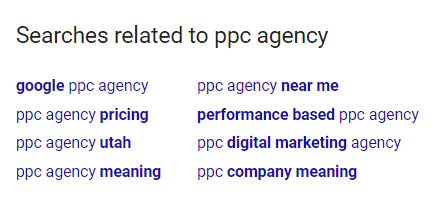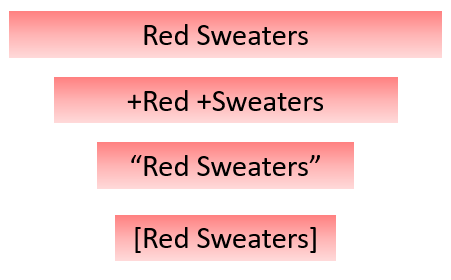Now that you have set up a Search Campaign, let’s talk about what you need to focus on to ensure you are running an effective campaign.
If you keep an eye on Keyword Strategy, Quality Score, Conversions and ROI, you will be well on your way to a successful paid search campaign in Google Ads. Today we will focus on Keyword Strategy – we will discuss the initial set-up as well as ideas for ongoing keyword management.
Keyword Strategy – Initial Set-Up
Keywords are the words you believe a customer would use to search for your product or service. They trigger an impression of your ad by telling Google that the word is relevant. Choose them carefully as you should ideally keep the count under twenty for each ad group.
Selecting the right keywords
How do you get your keywords right? The quickest way is to enter words you think your customers might use, and let Google Ads suggest related phrases. You could also conduct a Google search and see what Google suggests as related searches – see the screenshot below for what Google suggested when I used the search term “ppc agency”

I recommend going the extra step and actually observing a few users and their search behavior before you choose your keywords.
Picking the right match type
Google provides four different match types that you can use, depending on your marketing goals:
- Broad Match – As the name suggests, this match type casts the widest net for prospects. A store that sells women’s clothing could simply use that as a keyword and target anyone who is searching for women’s dresses, or sweaters, or pants, etc. Broad match keywords are written with no surrounding punctuation or marks, e.g.
Women’s Clothing
- Broad Match Modifier – This match type tightens the funnel. In the previous example, your ad might show up for someone looking for girls’ dresses. If you don’t want that, use a broad match modifier – modify the keyword by telling Google that a certain word MUST appear in the search term for your ad to show. In this case, you would edit your keyword thus:
+Women’s Clothing
- Phrase Match – This match type further restricts the funnel, by making sure that your ad is triggered only when someone is searching for your keyword or its’s close variant. e.g. the phrase match keyword would trigger your ad for the search term “clothing for women”. The phrase match keyword would look like this:
“Women’s Clothing”
- Exact Match – The most restrictive match type. Use this when you want your ad to show only for the specified words entered in the specified order.
[Women’s Clothing]
Keyword Strategy – Ongoing Management
Now that you have a set of keywords, let’s discuss tips and tricks for managing them.
- Go from Broad to Narrow
When you start a campaign, I always recommend starting with broad and broad match modifier keywords. This will give you a good sense of the kind of search terms your customers actually use, which you can add later on. This does not mean you should not use phrase or exact match, just that you should not exclusively use them. Once you get a good sense of how each kind of traffic behaves, you can tighten the funnel later.
- Mine Search Terms for Keyword Ideas
Some of the best keywords will come from scanning the search terms report to see which search terms customers are actually using. For one of my customers that sells mesh air filters, I was using branded terms along with the generic mesh filters terms. However, I noticed that sales were driven by customers looking for washable and reusable filters. I promptly added those terms both to the keyword list and to ad copy, which led to increased sales.
- Add Negative Keywords
I cannot emphasize this enough. Unless the only match type you are using is the exact match type, you need to review your account at least once a week to weed out irrelevant searches. Wasted clicks are wasted money. There are generic negative keyword lists available for free online that you can use; in addition, you need to look for search terms that include words that do not make sense specifically for your account. Creating negative keyword lists will save you time.
- Use Branded Terms
You own your brand, and you should definitely use branded keywords since they will be cheaper for you than for a competitor bidding against you. If you are a distributor of branded products, make sure you are following the trademark policy.
- Explore SKAGs
SKAGs stands for Single Keyword Ad Groups. Such an ad group revolves around a single keyword and includes the broad match, broad match modifier, phrase and exact match types for that keyword, and nothing else. This hyper-focused strategy, when used in combination with ad copy and a landing page that re-emphasize this focus, will help raise your Quality Score. SKAGs take time to set up but are well worth the effort.
In the next post, I will discuss Quality Score and what steps you can take to improve it.
